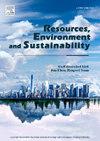基于知识引导的机器学习改进气候变化下内涝影响的作物产量预测
IF 12.4
Q1 ENVIRONMENTAL SCIENCES
引用次数: 0
摘要
极端降水对作物生产构成重大威胁,而基于过程的模式往往低估了这一点。由于过程的复杂性,最先进的模型也难以实现高分辨率空间应用。在这里,我们开发了一个知识引导的机器学习(KGML)框架,该框架将机器学习与支持涝害的APSIM(农业生产系统模拟器)相结合,以模拟气候变化下中国长江流域小麦产量的变化。利用迁移学习,该KGML框架将内涝过程转移到8个网格作物模型中,从而实现更准确的产量预测。研究发现,KGML可以准确地模拟改良APSIM模型在涝渍条件下的行为,模拟产量损失的R2为0.83,RMSE为272.3 kg/ha。土壤性质是影响涝渍下产量损失的主要因素,强调了优化土壤条件以减轻过量水分的不利影响的重要性。在不同的情景中,与原始模拟产出相比,改进的作物模型综合预测的作物产量损失更大,与历史时期相比,两个时期的额外损失约为5.9%-7.3%。尽管全球气候模式是T1期(2029-2059年)不确定性的主要来源,但作物模式对T2期(2069-2099年)的不确定性贡献更大。与原始模型相比,改进的集合减少了作物模型的不确定性。这项研究强调了KGML在改进作物模型方面的潜力,为气候影响评估和资源管理提供了有价值的见解。我们相信,我们的研究结果可以帮助国家和地方当局在气候变化的情况下做出明智的作物产量决策。本文章由计算机程序翻译,如有差异,请以英文原文为准。

Knowledge-guided machine learning for improving crop yield projections of waterlogging effects under climate change
Extreme precipitation poses a significant threat to crop production, often underestimated by process-based models. State-of-the-art models also struggle with high-resolution spatial applications due to process complexity. Here, we developed a Knowledge-Guided Machine Learning (KGML) framework that integrates machine learning with a waterlogging-enabled APSIM (Agricultural Production Systems sIMulator) to simulate wheat yield change under climate change in the Yangtze River Basin, China. Using transfer learning, this KGML framework transferred waterlogging processes to eight gridded crop models, enabling more accurate yield projections. We found that KGML could accurately replicate the behavior of the improved APSIM model under waterlogging conditions, achieving an R2 of 0.83 and an RMSE of 272.3 kg/ha for yield loss simulations. Soil properties were identified as the primary factors influencing yield losses under waterlogging, highlighting the importance of optimizing soil conditions to mitigate the adverse impacts of excessive water. Across different scenarios, the improved crop model ensembles projected greater crop yield losses compared to the original simulated outputs, with additional losses (compared to the historical period) around 5.9%–7.3% during the two periods. Although global climate models were the primary source of uncertainty in T1 (2029–2059), crop models contributed more to uncertainty in T2 (2069–2099). The improved ensemble reduced uncertainty from crop models compared to the original. This study highlights the potential of KGML to improve crop models, offering valuable insights for climate impact assessments and resource management. We believe our results can help national and local authorities make informed crop yield decisions under climate change.
求助全文
通过发布文献求助,成功后即可免费获取论文全文。
去求助
来源期刊

Resources Environment and Sustainability
Environmental Science-Environmental Science (miscellaneous)
CiteScore
15.10
自引率
0.00%
发文量
41
审稿时长
33 days
 求助内容:
求助内容: 应助结果提醒方式:
应助结果提醒方式:


